

Allpet Roaches(Blattodea)This site is dedicated to all roach enthusiasts. Allpet Roaches' goals are to promote the hobby and provide information and photographs on all the incredible looking cockroach species available. Less than 1% of roach species are pests and yet ignorance prevails. Few humans understand greater than 99% can survive indoors only as pets. They require nurturing to survive but the care requirements are easier and less expensive than those of other pets. Allpet Roaches began in 1980 with a gift of three male and three female Madagascan Hissing Cockroaches from the director of the Cleveland Aquarium. Allpet Roaches came online in 1998, and a message board (forum) for enthusiast's was added to the site in 1999. The Allpet Roaches book was published in 2000. The forum was moved to a different address in December 2001 and to a greatly improved format in July 2007. It is the longest running invertebrate board on the web. A long-time dream, a large coffee-table-size, color, hardcover "For the Love of Cockroaches" was published in 2016.
Malaysian zebra-stripe cockroach Dorylaea orini Where found: Malaysia.
Where found: Malaysia.Adult size: 30-35 mm (1 to 1 2/5 in). This beautiful addition to the hobby is relatively new to described species in the genus Dorylaea. It was named by Dr. Luis M. Roth of Harvard University in 2002 (Museum of Comparative Zoology type database 35085). Dorylaea orini sports the most striking nymphs available, while the adults are adequately pretty in their own right. This species is easy to keep in culture with standard care for tropical, ootheca-forming species. Warm temperatures and humidity are needed for gestation of ova. Petroleum jelly can be placed on the upper edges of the cage to hamper climbing. They readily climb smooth surfaces, like related Zebra and Harlequin roaches.
Zebra Roach Eurycotis decipiens Where found: Costa Rica.
Where found: Costa Rica.Adult size: 24-32 mm (1 to 1 1/4 in). For noticeable reasons this creature is called the Zebra cockroach. This striking, medium-size species is pretty both as adult and nymph. It can't fly but relies on warning coloration and defenses. The large cerci enhance the ability to escape by sensing the direction of the oncoming predator. The Zebra roach lays medium sized oothecae, slightly larger than those of Periplaneta americana. The ability to scale smooth surfaces is evident in this species but can be easily kept under control by liberal application of petroleum jelly to the top 51 mm (2 inches) of the sides of the rearing container.
Skunk roach Eurycotis floridana Where found: Florida, southern Georgia USA
Where found: Florida, southern Georgia USAAdult size: 24-40 mm (1 to 1 and 3/4 inches). A fellow roach hobbyist who keeps them says the defensive secretion smells like Amaretto, and he likes the smell. He is crazy! This adult is by far the largest of the common egg laying species kept in captivity, the oothecae are huge too. The background color of E. floridana is a deep maroon. In nearly all culture stocks, the medium-sized nymphs have yellowish margins along the sides of the thoracic segments but the adults are always completely maroon. There is also a rare culture stock from the Florida Keys in which the adults retain the nymphal striping. 1st instar nymphs of this species (and genus) are able to walk right over petroleum jelly barriers, so a sealed enclosure is necessary.
Click here for Eurycotis oothecae size comparison photo. Ornate Velvet Cockroach Deropeltis paulinoi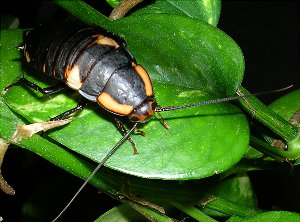 Adult length: 32-38 mm (1.1-1.3").
Adult length: 32-38 mm (1.1-1.3").Where found: Angola, Botswana, Congo, Namibia, Zambia -Africa Nymphs are orange with a large black central marking for the first few instars but later change over to black with orange markings. The adult female pictured looks very much like a large nymph. The fully-winged adult male looks like a small version of the Black Velvet roach Deropeltis erythrocephala male. It is a glass climbing species though it rarely climbs. It is oviparous and the oothecae are standard if a little elongate.
Porcelain roach Gyna lurida Adult length: 20-35 mm (3/4 to 1 and a half inches).
Adult length: 20-35 mm (3/4 to 1 and a half inches).Where found: Kenya, Africa Although adults of this Gyna species are often drab to porcelain white, there are occasional, spectacular, yellow adults. Nymphs are always very handsomely marked in mottled black and white. Adult males are small and brownish, while mature females are twice as big and most often a delicate porcelain color. The yellow form was isolated in the early 2000s so yellow or normal stocks are available. They possess incredible nervous energy but nymphs can't climb. The day active adults fly and jump like crazy and can take off from ground level. Patchwork cockroach G. bisannulata Orange head roach Eublaberus posticus Where found: South America.
Where found: South America.
The Orange head roach is a very colorful species considering it is nearly two inches long. Most roaches with much color are less than an inch. Orange head roaches have neat looking, deep maroon nymphs, which like to spend their lives buried under the substrate. E. posticus are among the more prolific of the pet roaches and with care will outgrow a large rearing container quickly. It is necessary to keep a bit of available protein on hand, such as dog food, to reduce wing biting. They are horrible wing biters. This is also the only roach I have seen that will actually eat other insects with zeal; any insect unable to get out of harms way is devoured. This species is one of the easily contained Blattodea since it is unable to climb smooth surfaces. Inability to climb glass is caused by the way the tarsi are structured. Eublaberus distanti , the Six Spotted Cockroach, has a similar body but is colored in tan and lacks the hunger for live food. The common name 'six spotted' refers to the six yellowish spots on the brown nymph. Pacific beetle mimic Diploptera punctata Where found: Asia and Pacific islands including Hawaii.
Where found: Asia and Pacific islands including Hawaii.The Pacific beetle mimic cockroach is certainly one of a kind. This is the only species of cockroach known to reproduce by vivipary. Females of other cockroaches produce oothecae which are either left to the environment, carried around, or drawn back into the body for protected incubation (live bearing). Diploptera punctata females, however, produce eggs internally which are quite small and are nourished much as in mammalian reproduction. Cuban burrowing cockroach Byrsotria fumigata Where found: Cuba, West Indies.
Where found: Cuba, West Indies.The Cuban burrowing cockroach is one of the more sexually dimorphic of the pet roaches. Not only do the male and female look very different, the female measures in at 40-45 mm (just under two inches) and the male at only 30 mm (just over an inch). Despite their designated common name, adults actually prefer to hide under bark with just the nymphs, as with many other types of roaches, burrowing. This roach is another of the wonderful species which cannot climb glass. Dwarf Madagascar hissing cockroach Elliptorhina Chopardi Where found: Madagascar.
Where found: Madagascar.Adult length: 36-42 mm (+-1 1/2 inches) The Dwarf Madagascar roach is a very neat little creature and is easy to distinguish from other hisser species by the small size and v-shaped horn formation on the male and smaller size. The coloration is generally different from Gromphadorhina but the various hisser species have somewhat variable colors. This species does not have a defensive smell and is not very fast but does have the ability to climb glass. Elliptorhina chopardi females are ovoviviparous and give birth to twenty to thirty tiny young. V-horn hissing cockroach Elliptorhina laevigata Where found: Madagascar.
Where found: Madagascar.Adult length: 44-70 mm (1.8 to 2.8 inches) The V-horn hisser is a rather huge species compared to other diminutive members of this genus like E.chopardi and E. javanica. V-horns do not have a defensive smell and are rather docile but they do have the ability to climb glass. They tend to be contrastingly marked but range to nearly black. Females are ovoviviparous and give birth to up to sixty babies. Madagascan hissing cockroach Gromphadorhina portentosa
 Where found: Madagascar.
Where found: Madagascar.The Madagascan hissing
cockroach is, without a
doubt, the most commonly kept cockroach in the United States and much of the world.
Most pet shops have had this neat creature at one time
or another. The "horns" or bumps on the male's pronotum are used in fights for breeding rights to the female. Still, it is very
uncommon to see males fight unless you constantly watch your Harlequin cockroach Neostylopyga rhombifolia Where found: Asia, Mexico, AZ (U.S.A.).
Where found: Asia, Mexico, AZ (U.S.A.).Size: 20-26mm (3/8 to 1+ inches) The Harlequin roach is certainly among the neatest looking of the pet roaches and is a very quick moving medium sized species. Nymphs start out life as a plain tan color but slowly molt to become very incredible looking adults. Harlequin roaches easily scale smooth surfaces and like most other glass climbers can be controlled by petroleum jelly. This is an egg laying species and fertility is sometimes a problem. Cultures either boom or bust so it is easy to rear a lot of specimens and easy for the culture to wipe out. Firefly mimic Schultesia lampyridiformis Where found: Central America and South America.
Where found: Central America and South America.The Firefly roach, being from South America, is a somewhat convincing mimic of the firefly beetles that live there. Unfortunately this small (13-20 mm) roach does not light up, but it is a good example of roaches that mimic beetles. S.lampyridiformis reproduces through live birth and the newly emerged nymphs are large (for babies) in comparison to the adults. Only a small number --around a dozen-- babies are produced each birth. This little roach is very quick and unfortunately both young and adults are more than happy to climb smooth-sided containers of aquariums and critter cages. The only way to guard against all escapes is to tape or hot glue microscreen to holes in an airtight containers, or to Velcro a screen lid onto an aquarium. Peppered Roach Archimandrita tesselata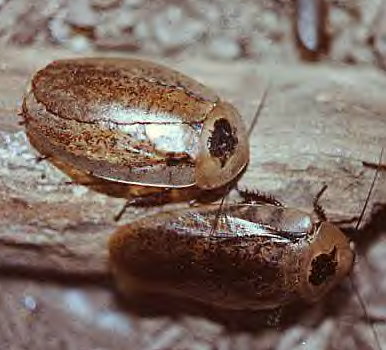 Where found: mostly in Central America from Guatemala to northwestern Columbia
Where found: mostly in Central America from Guatemala to northwestern ColumbiaArchimandrita tesselata is one of the more massive roaches with males being up to 70 mm (not quite three inches) and females being much bulkier but shorter due to their more rounded shape. Adults live a long time and do not put out defensive smells like many roaches. The peppered roach is becoming a more commonly kept species. Females have twenty to thirty babies at a time and keep their oothecae inside their bodies until hatching. Nymphs are slow growing and can take nine months or more to become adults. Adults do not fly well and neither adults nor nymphs are capable of climbing up glass which makes them easy to keep inside their home. Green Banana roach Panchlora nivea Where found: Cuba, Fl and TX: US, Mexico
Where found: Cuba, Fl and TX: US, MexicoThe Green banana roach is a very beautiful roach, unfortunately even a large female barely hits 24 mm (just under an inch)and the males are even smaller at 12-15 mm (half an inch). This is another ovoviparous species and out of the bright green adults are born tiny brown nymphs. The nymphs are burrowers and do not climb, on the other hand, the adults love to climb. If there is a crack, they will find it. Also, when you open the container, watch out! The Green banana roaches are great little flyers. Due to its lack of weight P.nivea is less easily controlled by petroleum jelly barriers than other Blattodea. Rhinoceros cockroach Macropanesthia rhinoceros
 Where found: Australia
Where found: AustraliaAdult size: 60-80 mm (2 and 2/5 to 3 and 1/5 inches) Despite the fact that the Rhinoceros roach does not have wings, this monster is still nearly as long as B.giganteus or Megaloblatta longipennis. Among the heaviest of all roaches M.rhinoceros has a meager diet and feeds upon dead Eucalyptus leaves in nature. It will eat dog food and fruits in captivity. These roaches are excellent diggers and have front tibia shaped like spiny shovels- similar to mole crickets. Nymphs can take five years to reach adulthood. The Rhinoceros roach is one of the very few insects that routinely lives over ten years. M.rhinoceros is uncommonly kept outside of Australia but there is hope; a number of captive reared nymphs have been legally imported into Europe and Japan. The photo on the left was taken by Christina Faull of her pet "Phoebe". The photo showing off the front legs, on right, by R.Dryer. Southern wood roach Parcoblatta divisa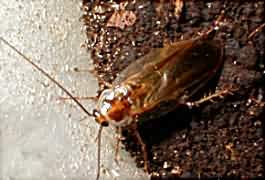 Where found: Pennsylvania to Louisiana, USA
Where found: Pennsylvania to Louisiana, USA Adult size: 14-22 mm (5/8 to 7/8 inches) The Southern wood roach is very similar to the Pennsylvania wood roach but is smaller and with less distinct coloration. Also, the first two segments (under the wings) of the male do not have overhanging ridges like males of P.pennsylvanica. Male Southern wood roaches often fly long distances before landing, contrary to the hop flying of most winged roaches. Females have reduced wings. Broad wood roach Parcoblatta lata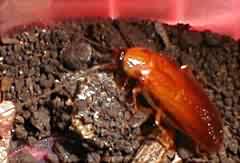 Where found: Northeastern US
Where found: Northeastern USAdult size: 14-19mm (3/5 to 4/5 inch) The Broad wood cockroach will feed on wood and dead leaves but enjoys dry dog food much more. Males are excellent flyers. Care is very similar to P.pennsylvanica and the adult lifespan is also short. Adults climb glass well and so must be kept in bounds by a Vaseline barrier. Pennsylvania wood roach Parcoblatta pennsylvanica Where found: Eastern North America
Where found: Eastern North AmericaAdult size: 18-28 mm (3/4 to 1 1/8 inches) The Pennnsylvania Wood Roach may nibble on wood, but needs fruit and dry dog food to survive in captivity. This is the largest of the Parcoblatta species. The fully winged males often fly to lights at night in their native range. The female produces a long, thin ootheca every ten to fourteen days. Adults climb glass well but they are easily kept in bounds by a petroleum jelly (or alternative slick surface) barrier. Simandoan Cave Cockroach Simandoa conserfariam Where found: Simandou Mountains, Guinea (origin).
Where found: Simandou Mountains, Guinea (origin).Adult size: 30-44 mm (5/8 to 1+ inches) Captive culture stock may be the only existing source for this species since its home was strip-mined for aluminum. This species is placed in the tribe Nauphoetini with lobster roaches and others. Likewise, it makes a squeaking noises when distressed. It shares husbandry requirements and behavioral traits with its cousins, but is more difficult to keep. Individuals average double the mass of the Giant Lobster Cockroach but not much longer. Newborn nymphs are solid brown, but they become more colorful after a few molts. Large nymphs are brightly marked with yellow-orange stripes. Madeira roach Rhypharobia maderae(previously Leucophaea maderae) Where found: Central Africa, Eastern US, South America
Where found: Central Africa, Eastern US, South America
Adult length: 35-48 mm (1.5 to nearly 2 inches). The Madeira cockroach is commonly found among ground litter and dead leaves. The wing design allows it to blend in well with brown, dead leaf litter. For fans of animal defensive mechanisms, this is the most magical of creatures. When picked up it squeaks noisily. At the same time it emits a horrible defensive smell like burning tires, while stabbing with the sharp spines on the legs, and flicking excrement with the rear feet. The Madeira is one of the most advanced caregivers of larger roach species with the females looking after nymphs nearly to adulthood! Nymphs can climb glass but adults don't seem to retain that ability. Giant lobster roach Henschoutedenia flexivitta Where found: Africa including Cameroon and Ghana
Where found: Africa including Cameroon and Ghana
Adult length: 32-38 mm (around 1 and 1/2 inches). Despite the common trade name, H. flexivitta is more closely related to the Madeira cockroach (above) than the Lobster roach, N. cinerea. Adults do somewhat resemble a rather large Lobster roach. The handsome nymphs are banded and look very different. This species can climb glass but prefers to stay on cage decorations like wood and egg carton. Females are live bearing. Culture stock dates to the 1980s but can be difficult to source. Too little heat or too much humidity can wipe out a colony rapidly. Lobster roach Nauphoeta cinerea Where found: Old World and New World tropics.
Where found: Old World and New World tropics. The Lobster cockroach is commonly kept in the U.S. but usually just as a food source for arachnids and lizards due to their ease of rearing and palatability. The body of this roach is soft enough for almost all predators, there is a high meat to shell ratio, they do not seem to be able to hide as well as many other roaches, and finally, they do not have the impressive defensive smell of many roaches. N.cinerea adults are supposed to feed on Green banana roaches in the wild but I have not tested this theory. Although able to climb glass this species is easily contained by using a greasy substance such as petroleum jelly around the top edge of the container. The above method only works with minimal success with some of the other glass climbers. Giant cave roach Blaberus giganteus Where found: Central and South America.
Where found: Central and South America.Adult length: 73-85 mm Blaberus giganteus is almost certainly the longest of the roaches that can be found in the worldwide cockroach hobby. A very large female can be close to 90mm (not quite 4 inches) and the wingspan of these critters is usually right at six inches! Males and newly emerged females are able to fly but older females get far too heavy. Males can be very aggressive; if only a few males are kept together they will fight and rip each others legs off and even kill one another. A number of males kept together usually prevents too much damage to any one individual. Death's Head Cockroach Blaberus craniifer
Where found: South Florida, Mexico, and Central America. Adult length: 44-58 mm This roach is the "real" death's head cockroach. The obvious reason for this name is the strange skull/vampire face markings on the pronotum. B.craniifer is the only species of Blaberus (there are a minimum of fourteen species) which has a very different color pattern from the rest of it's genus; even the nymphs are much darker. Adults like to jump/fly off your hands when held but are not too fast to be caught afterwards. Like the other Blaberus, the Death's head roach is ovoviviparous and cannot climb glass. Discoid roach Blaberus discoidales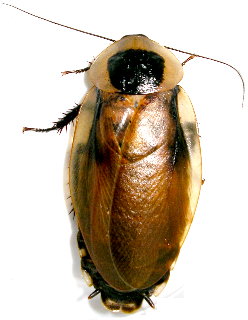
Where found: Mexico, South and Central America. Adult length: 35-45 mm For some incredibly strange reason this species was called Blaberus craniifer, the Death's head roach for a few decades or more years. Somebody must have misidentified this species and it has been traded around as the death's head ever since. The fact that there is no "death's head" marking on the pronotum of the adults of this species should be an obvious hint. It has also been sold as B. giganteus despite looking different and being much, much smaller. This is a prolific species which is easy to get a hold of and is an excellent food animal. Many people raise these to feed reptiles and arachnids. As with other Blaberus species, the Discoid roach is ovoviviparous and unable to climb glass. Click here for Blaberus sp. size comparison. Guyana spotted roach Blaptica dubia
Where found: Argentina, French Guyana, Brazil - South America. Adult length: 40-50 mm This species was a rare pet kept in the hobby until it became a very popular feeder animal early 2000s. It is still a great addition to any roach collection. The females have very short outer wings (tegmina) and the abdomens are spotted in red-brown, black, and buff. Females can be quite colorful. The adults and nymphs enjoy the usual roach fare (ie. dog food, vegetables, fruit) and are very active. Fortunately this species is unable to climb glass in either the adult or nymph stages. Formosan Sand Roach Unidentified polyphagid
Where found: Taiwan Adult length: 18-24 mm The Formosan Sand roach is a great little species with light tan to white, winged males and wingless females. It is an enigma because the stock came from Taiwan in the mid 1990s, but it may originate elsewhere. Furthermore, the stock may have died out (2017). It resembles Arenivaga sp. but is much, much faster growing and nearly double the weight (of the majority of species currently being kept). Females rarely live more than eighteen months as adults (much shorter than Arenivaga). Males are shorter-lived, but can survive six months. Oothecae are buried in the substrate. Nymphs and adults cannot climb glass. African Bullet Roach (Unidentified) Where found: Africa.
Where found: Africa. Adult length: 15-20 mm These interesting medium-small roaches arrived in the hobby in the late 1990s. When grabbed they exude a clear, sticky, and odorless substance. They reproduce very well but can be difficult to find in culture. The oothecae are nearly the same size and shape as Periplaneta although African Bullet adults are a bit smaller. All stages can climber glass. American cockroach Periplaneta americana "White-eye" form Where found: Nowhere in nature.
Where found: Nowhere in nature. Adult length: 20-30 mm This interesting strain of the common American cockroach has white eyes throughout its life. Natural forms of other roaches have black eyes even during molting. This mutation has been in culture continuously since the early 1940s. It is hard to say if this strain is blind or not because American roaches use many sensory hairs, antennae, and cerci, to get along. It is difficult to tell if eyes are necessary. This strain averages smaller than the standard form and does not breed quite as well. Of course it is an excellent glass climber and lays many oothecae. Domino cockroach Therea petiveriana Where found: India.
Where found: India. Adult length: 22-26mm. This magnificent looking cockroach mimics a warningly colored tortoise beetle. It is a somewhat slow growing species and the nymphs are substrate dwelling like other Polyphagids. Eggcases are buried and can take up to five months to hatch. Nymphs cannot climb glass but adults, especially males, are capable. The specimen depicted is male, females have less prominent antennae. Pale-bordered Field cockroach Pseudomops septentrionalis Where found: Louisiana, Texas, Mexico.
Where found: Louisiana, Texas, Mexico. Adult length: 9-15mm. This distinctive species makes up for its small size with strongly unique coloration. The antennae are black with a light orange band before the end. Pseudomops septentrionalis climb glass well and are quite energetic but usually stay on the decorations. Nymphs usually hide near the bottom of the cage and look like dark Parcoblatta immatures. Nymphs are long-live, usually around a year. Unfortunately the beautiful adults are very short-lived, just long enough to drink nectar, mate, and produce a few highly sculptured oothecae. The oothecae average two-dozen plus ova. Egyptian Desert Roach Polyphaga aegyptiaca Where found: Egypt
Where found: EgyptAdult length: 24-33 mm Polyphaga aegyptiaca females and nymphs have uniquely adapted legs. They have elongate rear legs so they never get stuck on their backs and shovel shaped forelegs for digging. The male is more of the standard roach shape. He is leathery black with full wings and a white margin on the pronotum and a white 'u' on the wings. Other Polyphaga sp. cultures contain only females (Parthenogenic) but this species is usually available as bisexual stock. Copyright. All rights reserved. Photos and information cannot be reproduced or transmitted in any form without prior written permission. Check these out:Support Allpet Roaches, get our book! Updated Cockroach Message Board
E-mail: elytraandantenna@lycos.com Hissing Madagascars and frenzied B.giganteus
|

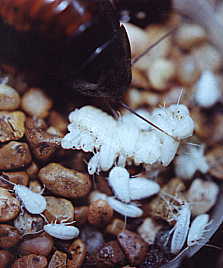 roaches. Hissers do not have a defensive smell but rely on their thickness of hide and noise-making
roaches. Hissers do not have a defensive smell but rely on their thickness of hide and noise-making
 abilities to defend themselves.
G.portentosa can range from 40-78mm (1 and 3/4 to 3+inches). Females among most cultures can reach seventy millimeters although males are normally much smaller. Males found in most cultures do not measure over 50mm unless they are obese. Common small male size is partly due to inbreeding and because small males
become adults more quickly and mate sooner. Adult coloration (the three males above left are from different stocks of the same species)
abilities to defend themselves.
G.portentosa can range from 40-78mm (1 and 3/4 to 3+inches). Females among most cultures can reach seventy millimeters although males are normally much smaller. Males found in most cultures do not measure over 50mm unless they are obese. Common small male size is partly due to inbreeding and because small males
become adults more quickly and mate sooner. Adult coloration (the three males above left are from different stocks of the same species)
